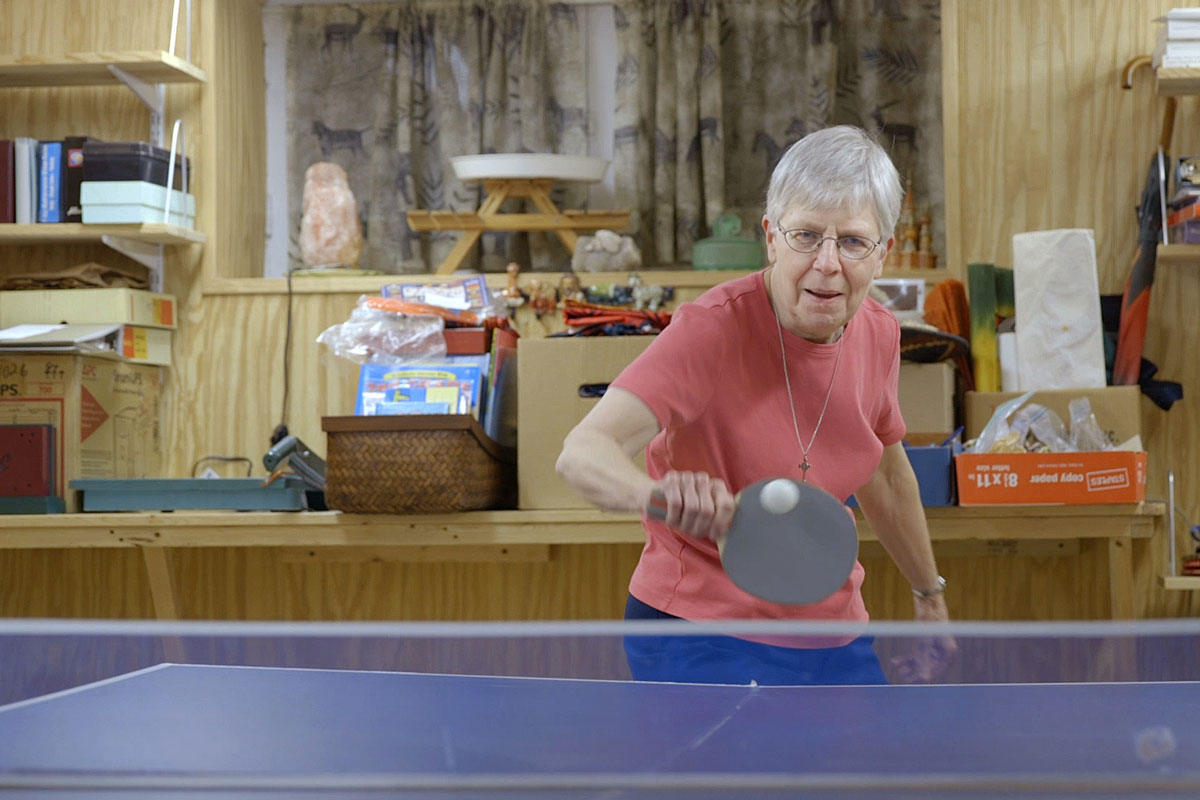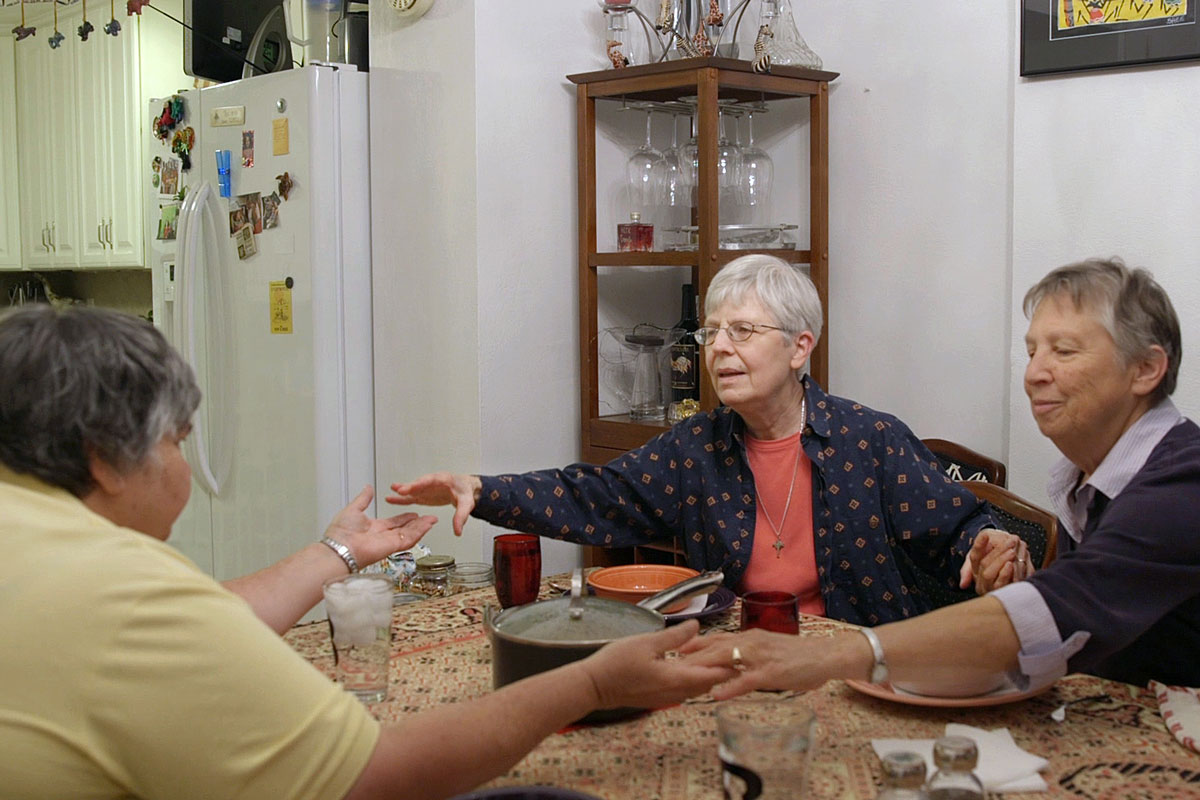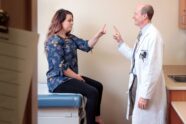Major Alzheimer’s study aims to predict who will develop the disease
$10.3 million also funds efforts to establish disease timeline
Huy MachJohn C. Morris, MD (right), director of the Charles F. and Joanne Knight Alzheimer's Disease Research Center at Washington University School of Medicine in St. Louis, examines a patient at the center. A long-term study of adult children of Alzheimer’s patients – led by the School of Medicine – aims to define who is likely to develop the disease and when, and to establish a timeline for how quickly the disease will progress.
Adults with an aging parent diagnosed with Alzheimer’s disease are at elevated risk of developing the disease themselves. But doctors still don’t know enough yet to predict which of these adult children will go on to develop Alzheimer’s. Nor can they predict at what age the characteristic symptoms of memory loss and confusion will appear.
A long-term study of adult children of Alzheimer’s patients – led by Washington University School of Medicine in St. Louis – aims to define who is likely to develop the disease and when, and to establish a timeline for how quickly the disease will progress.
The study, which began in 2005 with funding from the National Institute on Aging of the National Institutes of Health (NIH), already has helped identify some of the molecular and structural changes in the brain that occur in the decades before a person is diagnosed with the neurodegenerative disease. A grant renewal of $10.3 million from the National Institute on Aging extends the study another five years.
“Our participants want to know if and when they will experience symptoms such as memory loss,” said John C. Morris, MD, the Harvey A. and Dorismae Hacker Friedman Distinguished Professor of Neurology and director of the Charles F. and Joanne Knight Alzheimer’s Disease Research Center at Washington University. “We anticipate that in the next five years we can begin to tell them.”
Knowing that the disease is coming is one thing; treating it is another. No therapies have been proven to cure the disease or even slow it down. However, Morris and his colleagues say that people on track to develop Alzheimer’s could be directed into clinical trials of investigational drugs that may delay or even prevent onset of symptoms.
Morris is the principal investigator of the Adult Children Study, which recruits and follows people ages 45 to 74 who have no problems with memory or thinking. Most participants are at elevated risk for developing Alzheimer’s because one or both of their parents has or had the disorder. Adult children with parents who were never diagnosed with the disease serve as a comparison group.
 Huy Mach
Huy MachThe study follows both groups over time, measuring participants’ memory and thinking skills, as well as taking scans of their brains and measuring levels of key Alzheimer’s proteins as the people in the study age.
The new round of funding is geared toward developing a set of criteria to predict the onset and trajectory of the disease. Doing so requires a detailed understanding of the changes that occur during the 15 to 20 years before enough brain damage accumulates to cause symptoms. The researchers plan to winnow down a long list of criteria to find those most useful for prediction. With these criteria in hand, the researchers will be able to better design clinical trials to prevent or delay the disease.
The study participants regularly come to Washington University’s Knight Center to undergo memory and cognition tests. And now they will be able to test memory and thinking at home on a smartphone. If this technology is successful, it may reduce the need for people to travel for testing.
Once every three years, participants undergo brain scans to determine the size, thickness and connections between different parts of their brains, and to locate clumps of toxic Alzheimer’s proteins. The new funding will allow the researchers to evaluate whether two new imaging compounds can more precisely detect the Alzheimer’s proteins tau and amyloid beta.
The participants also undergo a spinal tap to measure levels of amyloid beta and tau in their cerebrospinal fluid, as well as levels of other proteins associated with neurologic damage and inflammation.
While doctors cannot yet offer a therapy to prevent Alzheimer’s, the knowledge that the disease is on the horizon may nonetheless be helpful to older people and their families.
“If you knew that you were at high risk to develop Alzheimer’s dementia in the next few years, you might make some changes to your life,” said Tammie Benzinger, MD, PhD, an associate professor of radiology who directs the imaging studies in the Knight Center. “You might choose to move to an independent-living environment that also provides nursing care. You might choose to move closer to your children.”
Further, people who currently are healthy but at increased risk to develop Alzheimer’s disease represent an ideal population to test preventive therapies. It is possible that drugs have failed to demonstrate benefit in the past because they were tested in people who already had an Alzheimer’s diagnosis. People with symptoms severe enough for diagnosis already would have sustained profound damage to their brains.
“By the time symptoms bring people into the clinic, their brains are already atrophied,” said Anne Fagan, PhD, a professor of neurology who heads the biomarker portion of the study. “It is highly unlikely that any sort of intervention is going to bring back neurons that have died. But if we can identify people with underlying pathology while their thinking skills are still intact, we can put them in clinical trials to try to stop, or maybe even reverse, the disease process.”
The goal is to catch people on their way to developing Alzheimer’s and intervene so they never get there, much as doctors today measure blood cholesterol levels and, if necessary, prescribe cholesterol-lowering drugs to avert a heart attack.
The Adult Children Study team is recruiting new participants.
“Our research participants are unbelievably committed,” Fagan said. “They have families. They have jobs. Some are taking care of parents with Alzheimer’s or other diseases. And yet they come in, on schedule, and do all these things for us. Their dedication is amazing. Our hats are off to them.”
For more information, visit http://alzheimer.wustl.edu/Volunteer/ACS.htm or call 314-286-2683.
 Huy Mach
Huy Mach



 Related:
Related: 

